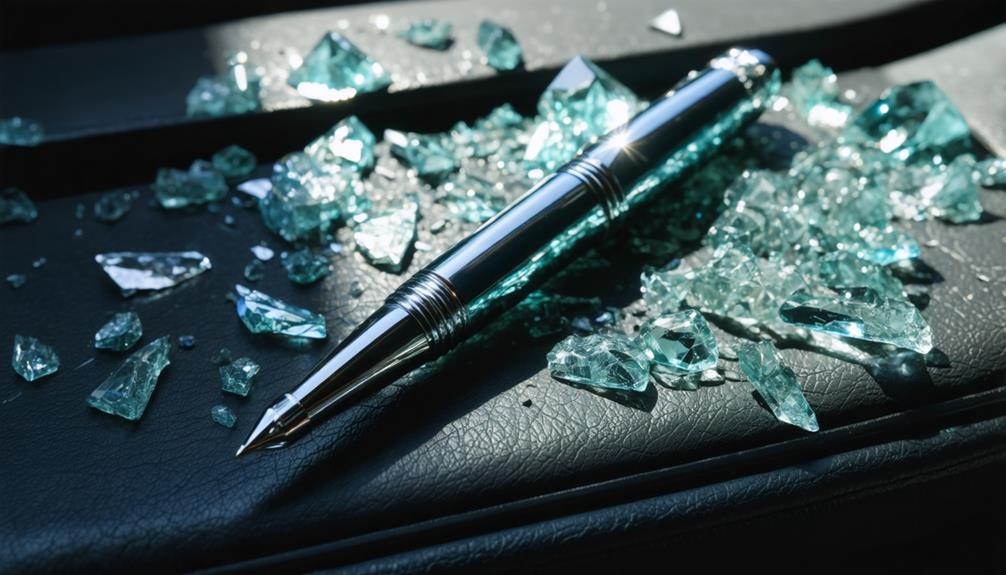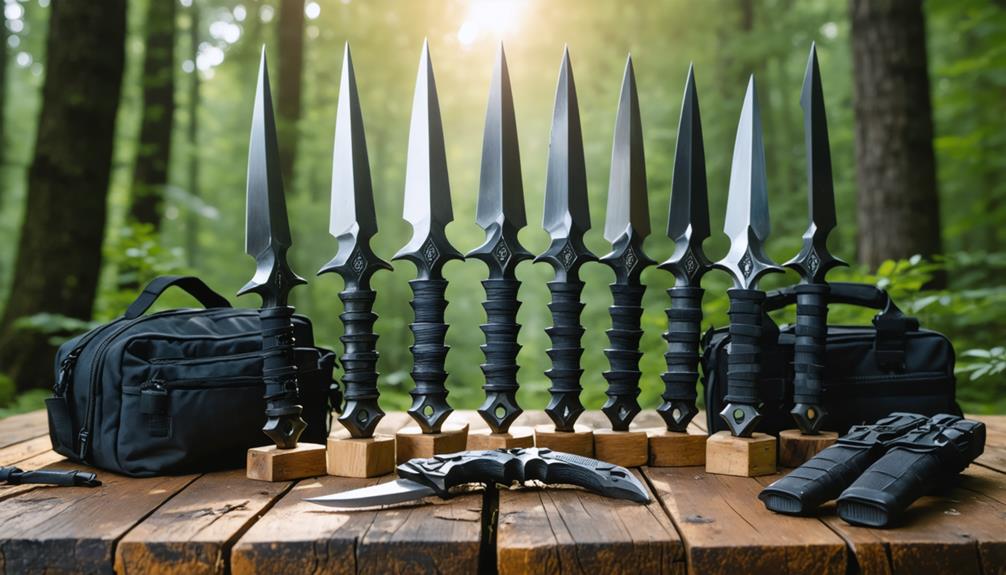
Brainstorm Security Shop

For Orders Over $199

On Any Of Our Products

Details On Refund Page
When you think about self-defense, the choice of throwing knives can significantly impact your effectiveness. You’ll want to focus on factors like weight, balance, and material to ensure they perform well under pressure. Knives such as the Cold Steel Trueflight or the SOG Fusion series stand out for their accuracy and durability, making them viable options. However, understanding the nuances of each knife’s design and how it affects your technique is just as important. Curious about the key features that really set these knives apart?
When you’re looking at throwing knives for self-defense, you’ll want to keep a few key features in mind.
First, consider the blade design. A well-designed blade can significantly impact your throwing accuracy and effectiveness. Look for blades that are balanced and have a pointed tip, which can help penetrate targets more easily. Some designs come with a wider blade, which can increase the impact but may reduce speed.
Next, think about weight distribution. The knife’s weight affects how it flies through the air and its stability upon impact. Ideally, you want a knife that has a balanced weight, allowing for smooth throws without excessive wobbling. A knife that’s too heavy can be cumbersome, while one that’s too light may not stick to the target effectively.
Finding the right balance between blade design and weight will enhance your throwing experience. Remember, you’re not just looking for something that looks cool; you want a tool that you can rely on in a critical situation. Assessing these features will help you make an informed choice when selecting the ideal throwing knife for self-defense.
Explore the best throwing knives on the market to find the perfect fit for your self-defense needs. You want knives that are reliable and effective, so consider these top choices:
1. Cold Steel Truesflight Throwing Knife
This knife is designed for precision with a blade weight of 12 ounces, ensuring stability at longer target distances. Its excellent blade sharpness makes it a standout option.
2. SOG Fusion Throwing Knives
Weighing in at 8 ounces each, these knives offer a great balance for accuracy. Their ergonomic handle design provides a comfortable grip, allowing for quick, controlled throws.
3. Perfect Point Throwing Knife Set
With a lightweight design and impressive blade sharpness, these knives are ideal for beginners. The handle design allows for easy maneuverability, perfect for different target distances.
When choosing the right throwing knife, think about how the blade weight and sharpness affect your accuracy, as well as the handle design for comfort. Each of these knives has unique features that cater to your self-defense strategy.
Understanding the materials and construction of throwing knives is crucial for selecting the right tool for self-defense. Different materials can significantly impact a knife’s performance, durability, and effectiveness. For instance, stainless steel is often preferred for its corrosion resistance and strength, while high-carbon steel can offer better edge retention and blade sharpness.
When assessing a throwing knife, consider the weight distribution. A well-balanced knife will fly true and stick better upon impact. Ideally, the center of gravity should be positioned towards the blade, ensuring stability during flight. This balance not only aids in accuracy but also makes it easier to control the knife, which is vital in self-defense situations.
Additionally, pay attention to the blade sharpness. A sharper blade penetrates targets more effectively, increasing your chances of success in a high-stress encounter.
Knives with a strong tip and a sharp edge will perform better, whether you’re throwing them or using them in close quarters.
To effectively use throwing knives for self-defense, you’ll need to focus on your grip and stance, which set the foundation for accuracy. Mastering aiming techniques is essential to ensure your throws hit the intended target. Regular practice will sharpen your skills and boost your confidence in critical situations.
Mastering the grip and stance for throwing knives is crucial for accuracy and control. When you throw, the right grip and stance can significantly enhance your performance. Here are three key elements to focus on:
Aiming is the cornerstone of effective knife throwing, and honing this skill can make all the difference in your accuracy. First, focus on distance control. Understand how far you’re from your target, as this will determine how you throw your knife. Adjust your technique based on whether you’re standing closer or farther away.
When you’re near the target, you might use a wrist flick, while a longer distance requires a more deliberate motion to ensure the knife rotates properly.
Next, consider your target selection. Not all targets are created equal, especially in a self-defense scenario. Choose a target that’s both clear and accessible, aiming for areas that will maximize your chances of a successful hit. Remember, it’s not just about hitting the target but also about hitting a vital area if necessary.
Practice visualizing your throw before executing it, ensuring that you’re aware of both your stance and your grip. This mental preparation will aid in achieving better aim. With consistent focus on distance control and making smart target selections, you’ll enhance your knife-throwing skills significantly, making you more effective in self-defense situations.
Consistent practice is essential for sharpening your knife-throwing accuracy. To enhance your skills, you’ll need to focus on target practice and technique improvement. With dedication, you can master precision throwing and distance control, making your throws more effective in any situation.
Here are three key areas to concentrate on during your practice sessions:
When you’re throwing knives, proper handling techniques are crucial to ensure your safety and the safety of those around you.
Always choose a safe throwing environment, free from obstacles and bystanders, to minimize risks.
Handling knives safely is crucial for effective self-defense and personal safety. When you’re using throwing knives, proper handling techniques ensure you minimize risks while maximizing your effectiveness. Here are three key tips to keep in mind:
Creating a safe throwing environment is just as important as mastering your handling techniques. First, focus on target selection. Choose a sturdy target that can absorb knife impacts without risk of ricochets. This minimizes the chance of injury to yourself or others.
Next, consider your practice space. Ensure it’s clear of obstacles, people, and pets. A wide-open area helps prevent accidents and allows you to throw without restrictions. Keep a safe distance from the target—ideally, 10 to 15 feet—so you can practice effectively while maintaining control.
Lighting conditions play a crucial role, too. Always practice in well-lit areas to enhance your visibility and accuracy. Poor lighting can lead to misthrows and increase the risk of injury.
Lastly, establish safety boundaries. Mark off a zone behind the target where no one should be during practice. Inform anyone nearby about your activity to avoid surprises. By following these safety tips, you’ll create a secure environment that lets you focus on honing your skills without unnecessary risks.
If you’re looking to purchase throwing knives, several options are available to fit your needs. You can explore both online retailers and specialty stores, each offering unique advantages. However, it’s essential to consider quality vs. price to ensure you’re making a worthwhile investment.
Here are three places to consider:
Whichever route you choose, always prioritize customer reviews to help you make an informed decision. Quality knives are worth the investment, ensuring you have the best tools for self-defense.
Throwing knives’ self-defense legality varies by state regulations. You’ll need to check local laws, as some states permit them while others impose restrictions. Always ensure you understand your local regulations before carrying them for self-defense.
When you travel, you need to check travel restrictions and international regulations regarding carrying throwing knives. Different countries and states have varying laws, so it’s crucial to research before packing them for your trip.
To maintain your throwing knives properly, use cleaning techniques like soapy water and a soft cloth. For storage options, consider a dedicated sheath or wooden block to keep them safe and in optimal condition.
The average lifespan of a throwing knife varies, but with proper throwing knife maintenance, you can enhance its durability. Regular care, like cleaning and avoiding rust, can significantly extend your knife’s usefulness and performance.
Yes, there are age restrictions for purchasing throwing knives, varying by location. You should check your local laws for legality. Always prioritize safety tips and training techniques to ensure responsible handling and usage.
